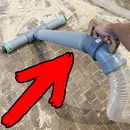Introduction: DIY LED Log Lamp
What could be done with a log, few lightbulbs, and a flax rope? Simple, one awesome looking ceiling lamp!
Well, I needed a new lamp in my kitchen. Furniture stores were a big no-no as I wanted something that would look cool, be natural and could be made with my own two hands. I knew I had all the tools I needed so I was eagerly waiting for the weekend to get in my workshop. In only a day I managed to craft this lamp that will illuminate my kitchen for years to come.
Although I failed on my first try I still managed to build something that I am really happy with. I am sorry that there are not many photos of the lamp switched on. The reason for this is simple - the light is quite bright and I do not yet have skills (nor equipment) to take good photos of it. The video, on the other hand, gives a nice overview.
I hope my work inspires some of you. If not, then just enjoy the video and the ´ible.
Oh, and I would really appreciate if you voted for me. And subscribing would be awesome too!
Step 1: Tools and Materials
For milling:
- Chainsaw
- Long bendable ruler
- Pencil
- Power planer or hand plane
- Axe and wire brush for removing the bark
You will also need
- Circular saw or handsaw
- sharp hand plane
- Random orbital sander or any other sander
- Corded drill with spade or forstner bits
- Chisel and hammer or electric scraper or electric multi-tool
- Hot glue gun or blow torch (with hot glue sticks)
- Pencil /ruler
To make a lamp similar to mine you will need:
- Milled up log (hardwood)
- Thin plywood
- Flax rope
- 1,5 gauge electrical wire ( and wire clips)
- Light bulb sockets
- Retro LED light bulbs (from Sylvania)
Of course, there are endless ways to customise your lamp so feel free to do your own modifications ;)
Step 2: Milling the Log
This might seem complicated but really it is not. You could have your log milled by professionals, buy/build an Alaskan mill or buy already milled up lumber (the easiest). Since I did not want to do any of that I decided to try it freehand. Though this means that you should have power planer as the cut surface is pretty rough (hand plane works too but requires much more time).
I started by cleaning the log with an axe and steel brush. Then I marked the initial length with a bendable ruler. After the horizontal cut was done I moved to vertical cuts. This requires quite a sharp chain so be sure to sharpen it if necessary. The process was pretty much the same but in between the two cuts I planed the surface as it allowed to mark the second cut more precisely and thus cut straighter.
The wood I was planning to use was from an old birch tree that fell down in our garden quite some time ago. I thought it was dry enough but as it turned out it was not. I realised this pretty soon after milling. To wood felt wet to touch and had several rotten spots. And to make the matters worse it also had fungus. The tree actually fell because of a fungus infection so it was not a big surprise. Considering all that I decided to leave it here and find another solution. Though I have to say that the grain looked super beautiful on the birch. I think it was caused by excessive water but I am not sure. Maybe some of you know (let me know in the comments)
As I could not use this lumber anymore but still wanted a lamp I decided to use already milled up lumber that we had. I think it was black alder ( Alnus glutinosa). This one had a huge added bonus - it had bark still attached!
Step 3: Second Try
This slab came 1.5 meters long so I had to shorten it . I did it with a circular saw. If your saw does not cut all the way through you can finish it up with a hand saw. Then it is just a bit of planing and sanding to get it flat and smooth.
I started by marking and drilling out ( no, I did not actually use a hammer to make them :D ) holes for the sockets. Be sure to mind the depth!
Next up it was making the cavity for the wiring and lightbulb sockets. I started with a router straight bit) to create a small lip. This would later hold the plywood hatch. I tried several (dangerous) methods to remove the material and I found that corded drill with spade bit works the best. I drilled several holes and later removed the leftover with a chisel and a hammer. An electric scraper or electric multi-tool makes this process much easier. I used the first one.
The hatch was made from 3mm plywood and was cut out using table saw (circular saw)
Note that I used shower mat under my workpiece. This is a simple and very inexpensive solution to avoid slipping and damaging your project.
Step 4: Sockets and Wiring
When the cavity was done I added the sockets and did the wiring.
If your glue gun refuses to cooperate and you smash it, know that a blow torch works perfectly fine. Heat the glue stick in the flame and apply it to the surface you wish to glue.
Wiring is also pretty straight forward but if you feel uncomfortable ask someone (who knows what he/she is doing) to help you.
After adding the hatch and fine sanding I applied few coats of water-based lacquer. Also on the bark - this makes it more solid.
At this point, it is ready to hang!
Step 5: Setting It Up
To hang it from the ceiling I used eye hooks.
I found that laser level helps to align the lamp exactly where you want it (keeping the ropes perfectly vertical). I first placed the lamp on a table, then I aligned the laser line with the rope holes. I marked a small line to the ceiling and repeated the process on the end grain side. Then I just screwed in the hooks in and added the ropes. Electrical wire is twined around one rope.
Unless you have a super accurate eye I suggest you use a small bubble level to see if the lamp is level.
Finally, I added the lid, screwed in the bulbs and flicked the switch. *KABOOOM* (thankfully not :) . Oh and I do not know if you noticed but the cavity in there is kinda big. If you do the wiring like I did ( neatly secure the wire to the corners with wiring clips) then you should have a nice spot to hide your valuables. For example, I use it to hide candies from my sweet tooth girlfriend .
Step 6: The End
All in all, I am super happy how this turned out. I love it myself and I have already gotten really positive feedback from other people. I think the first version would have not looked so good (everything happens for a reason) as it was much bulkier and did not have bark. What do you think?
One thing that I would do differently are the bulbs. Each one of them emits 420 lumens so four of them add up to a super bright light. I can change them when these ones burn out, but it is not going to happen anytime soon (in 6 years with a usage of 2.7 hours per day). Another solution would be to use dimmer but make sure your bulbs are dimmable !(mine are not)
If you have any questions or comments feel free to express them down below!
I would really appreciate if you voted for me. And subscribing would be awesome too!
Take care,
Andu

Runner Up in the
Lamps and Lighting Contest 2016

Participated in the
Wood Contest 2016

Participated in the
LED Contest













